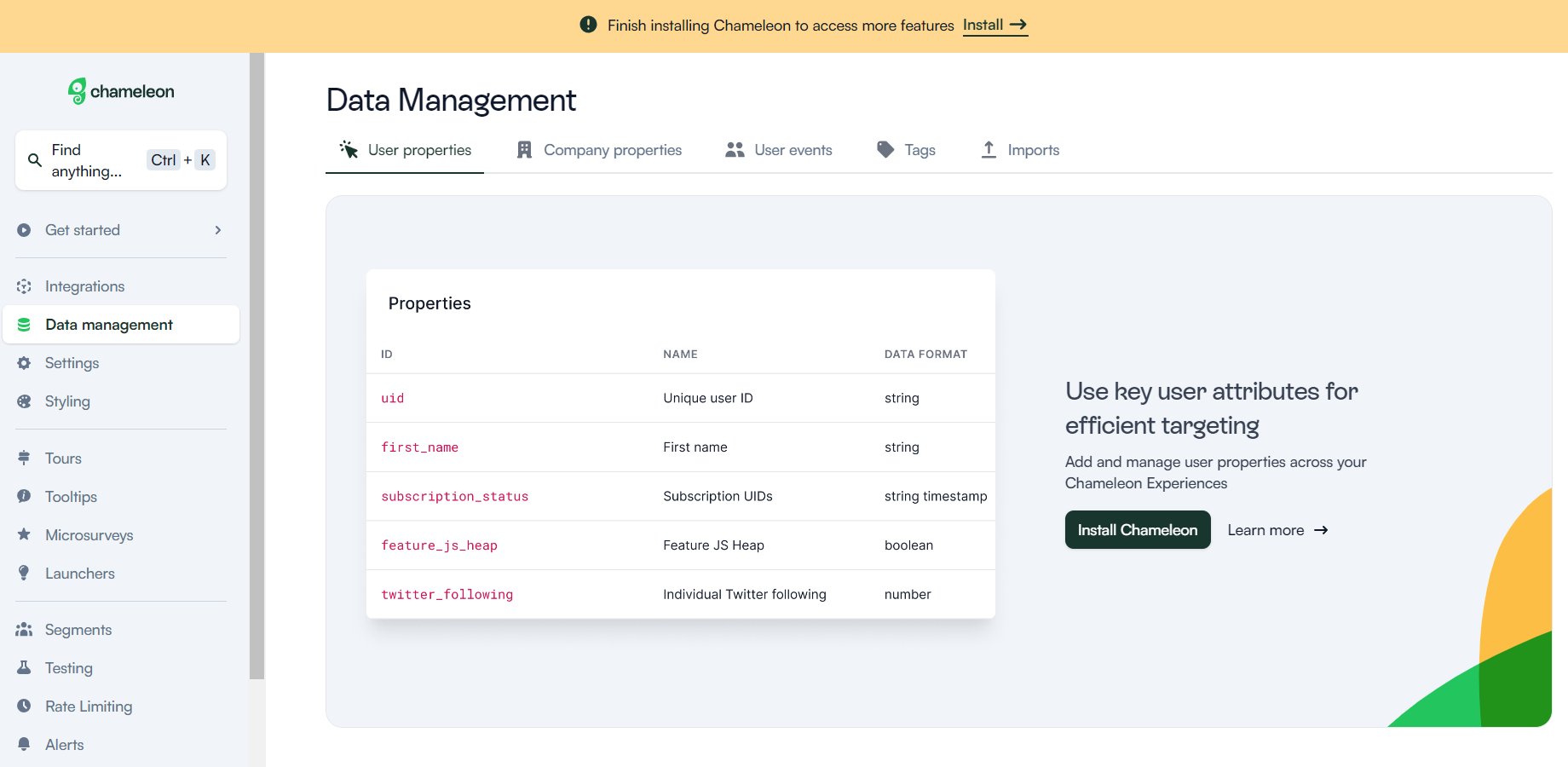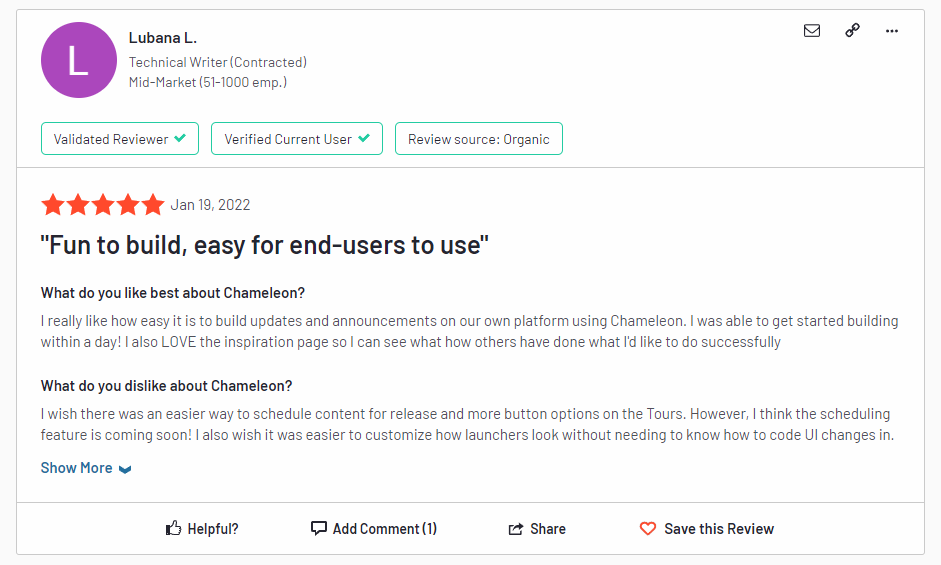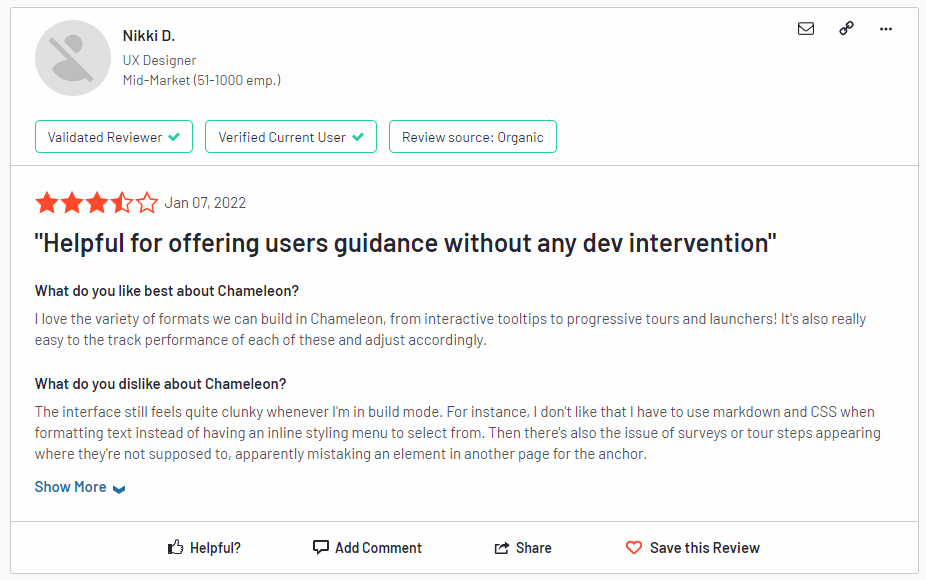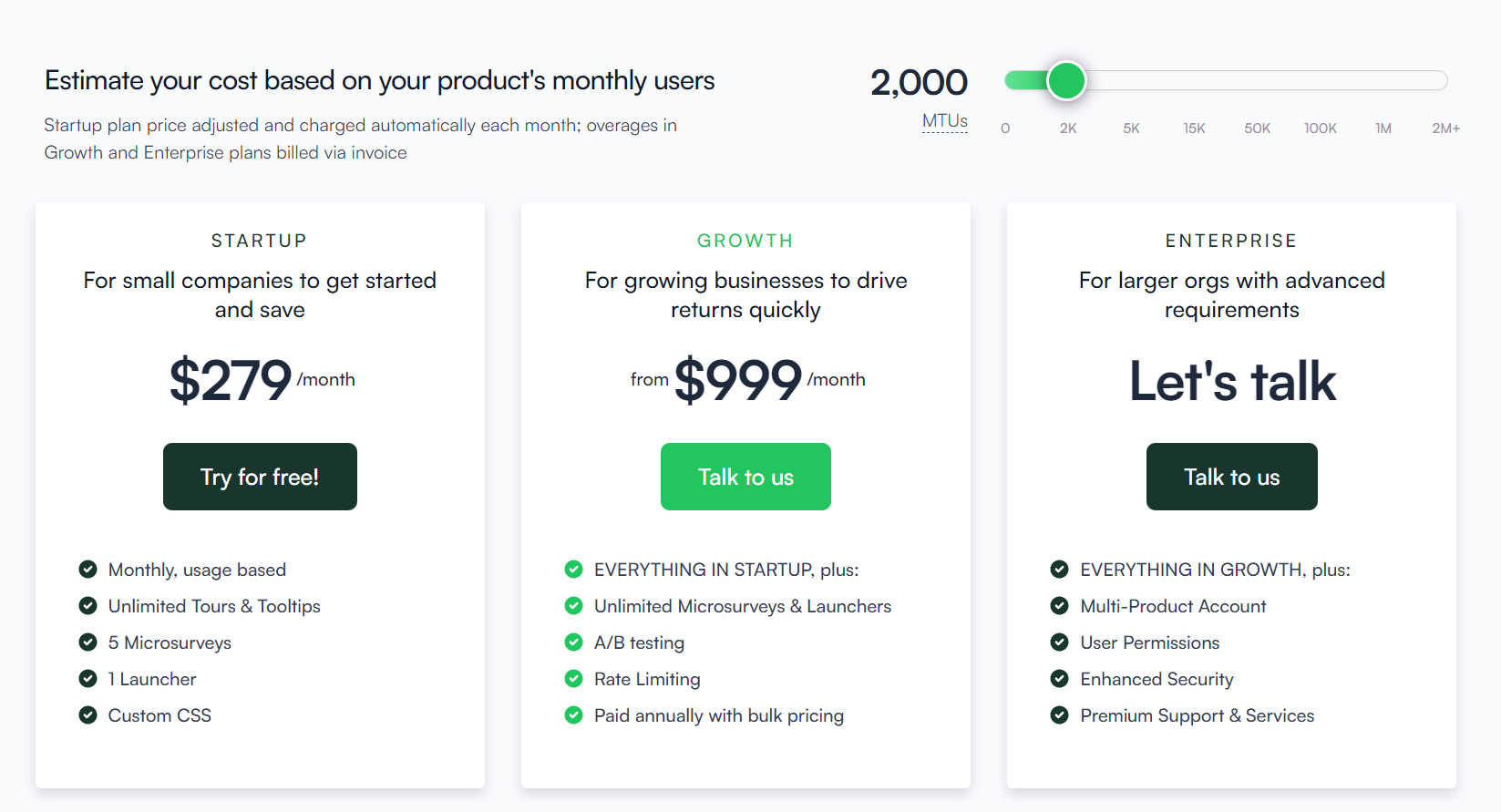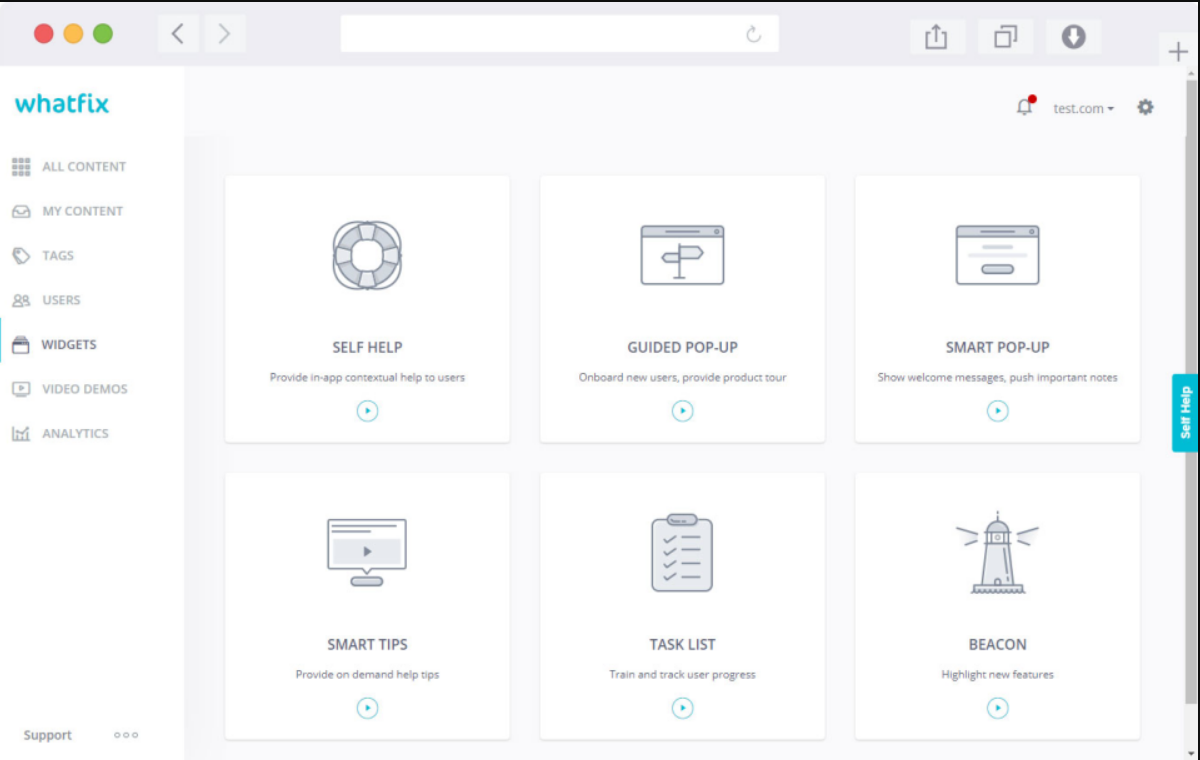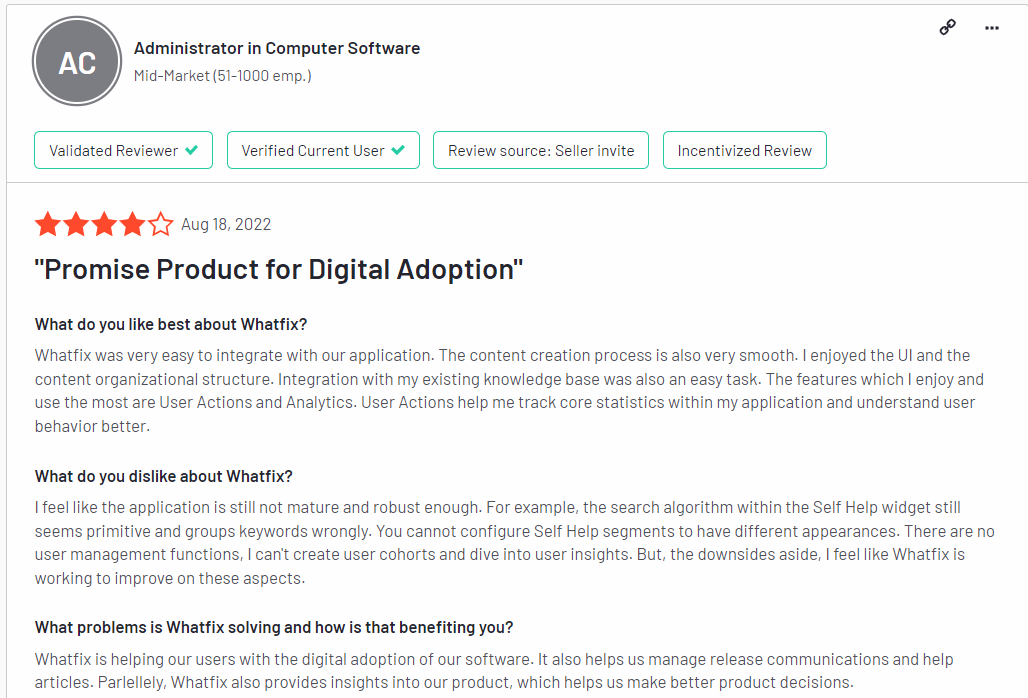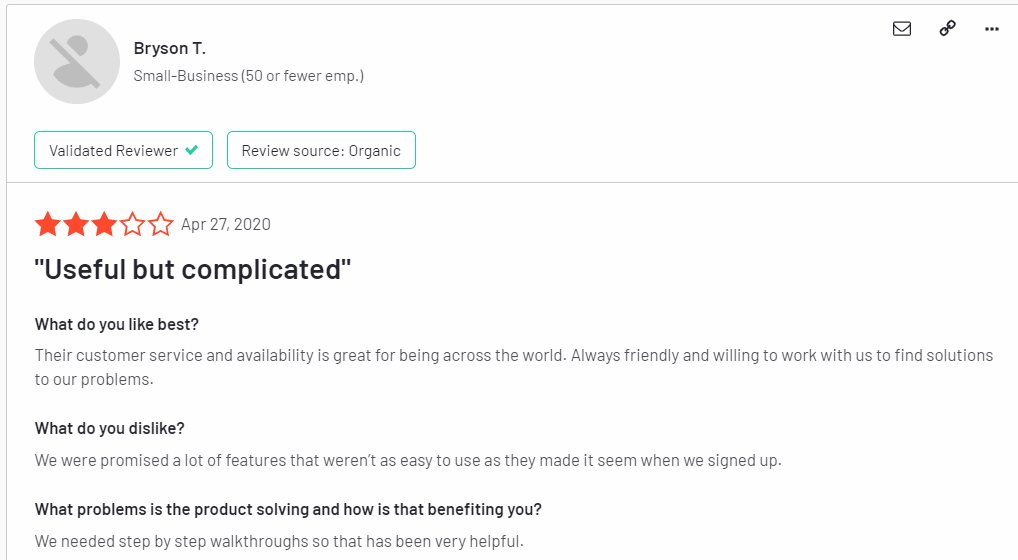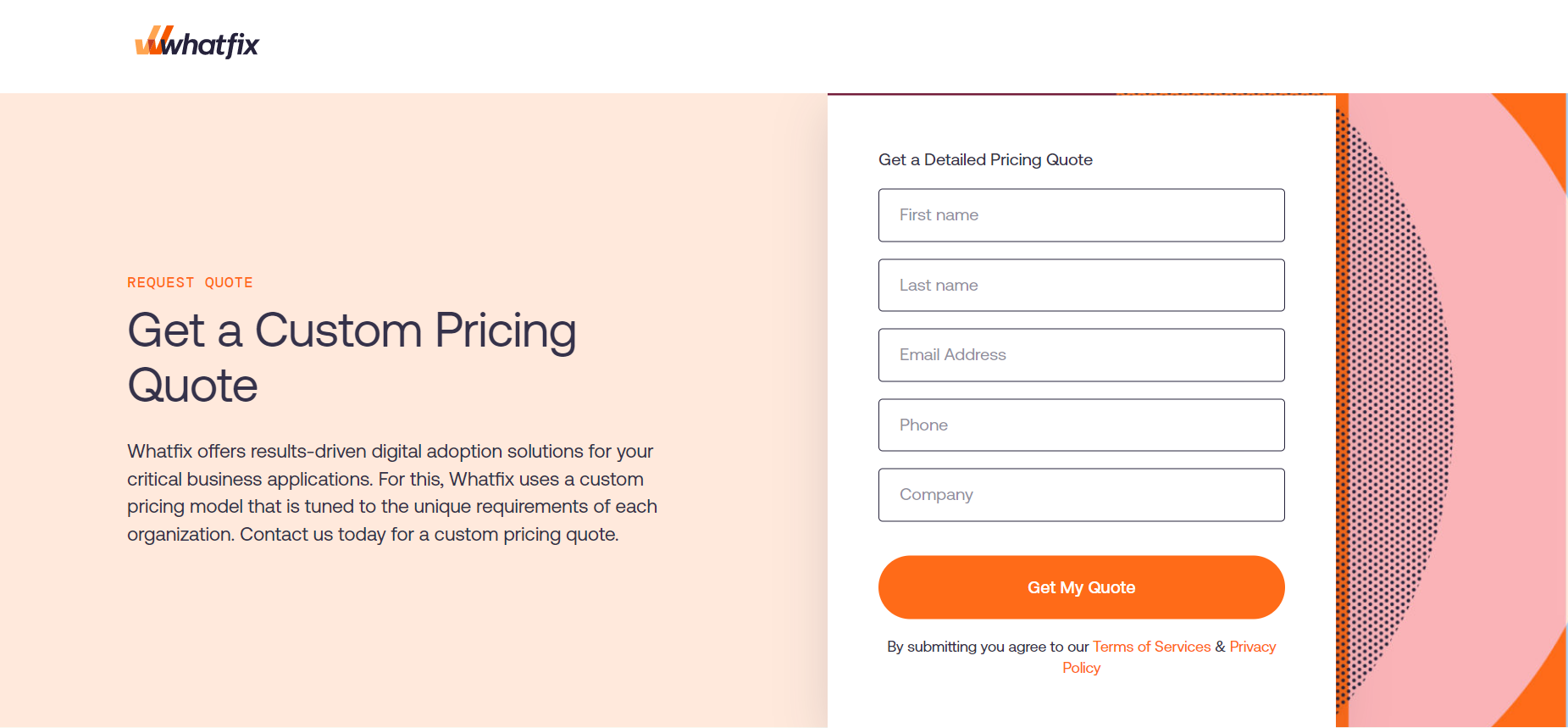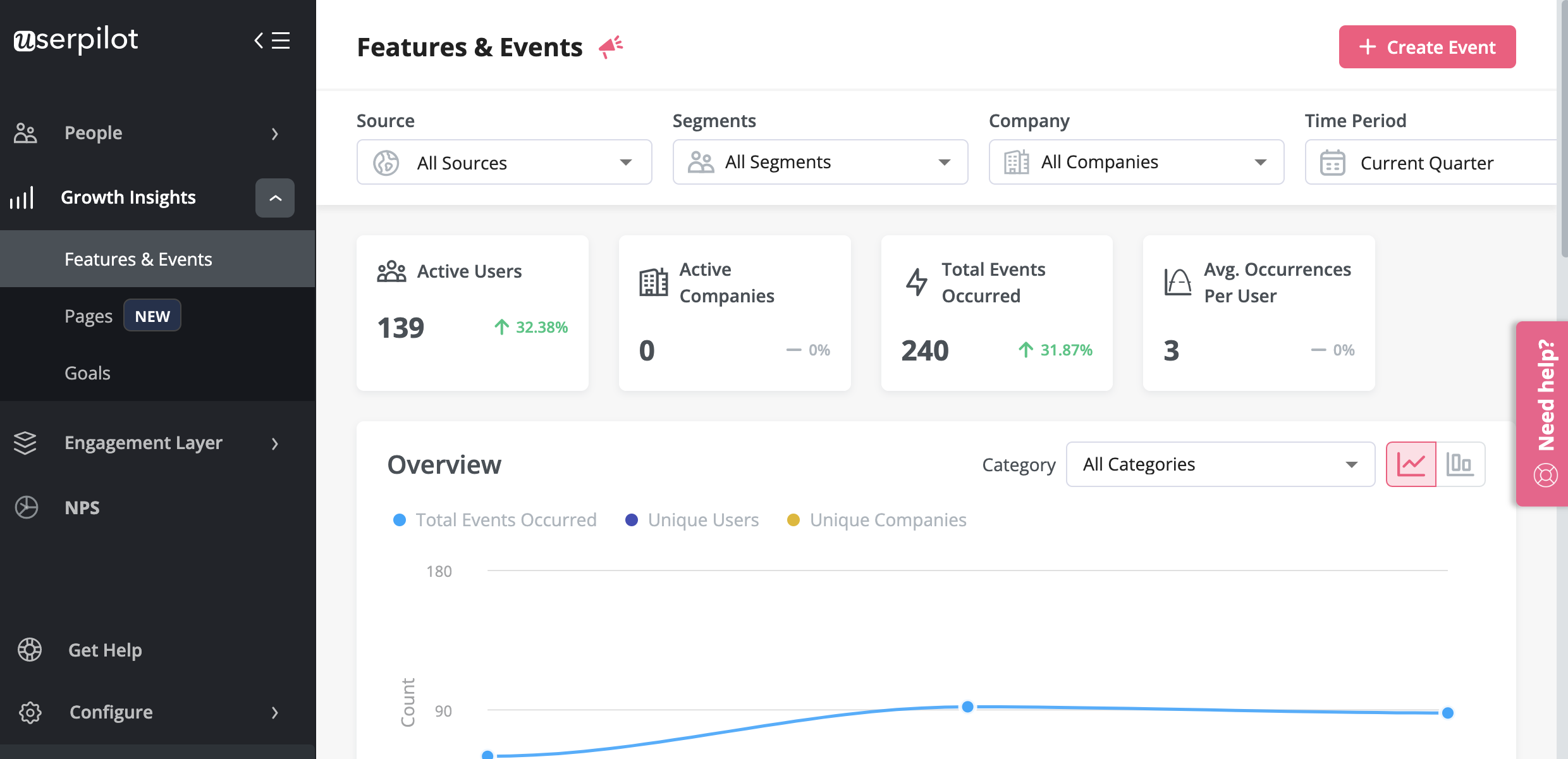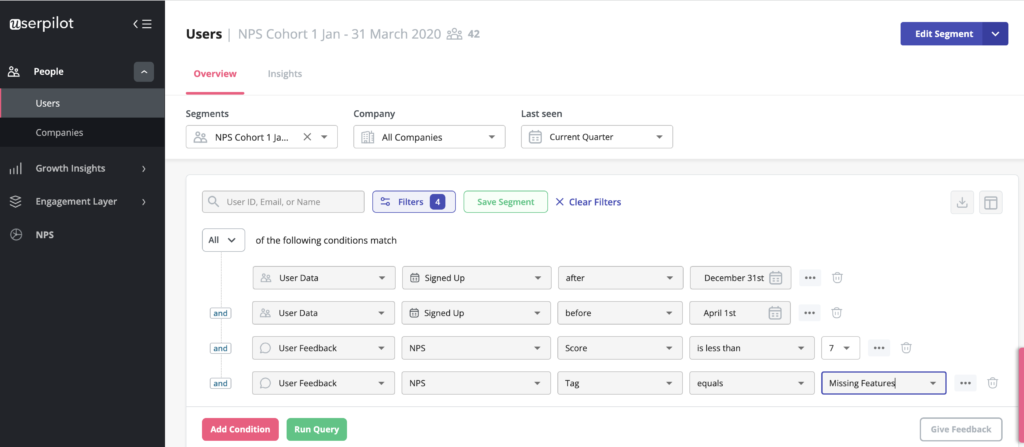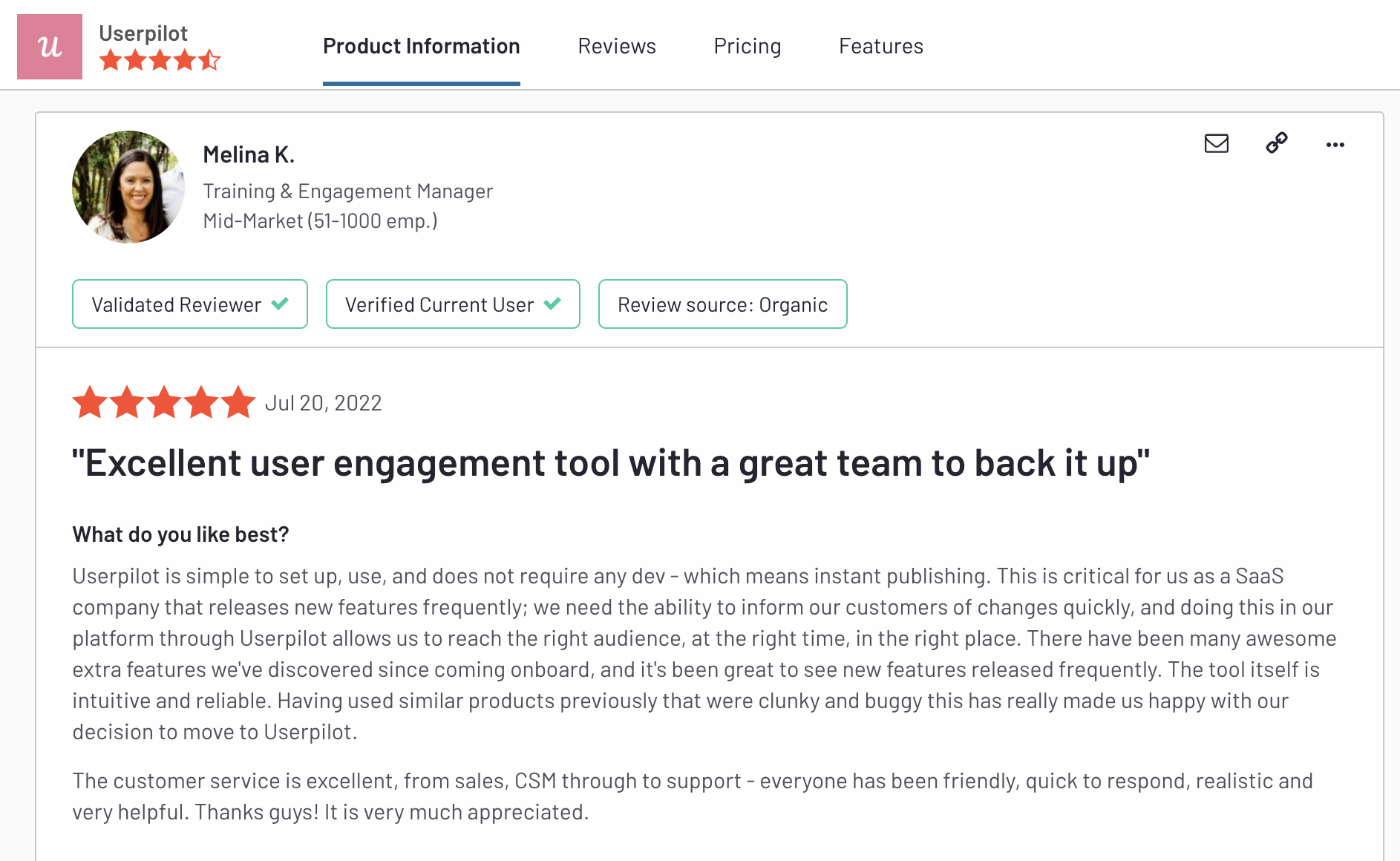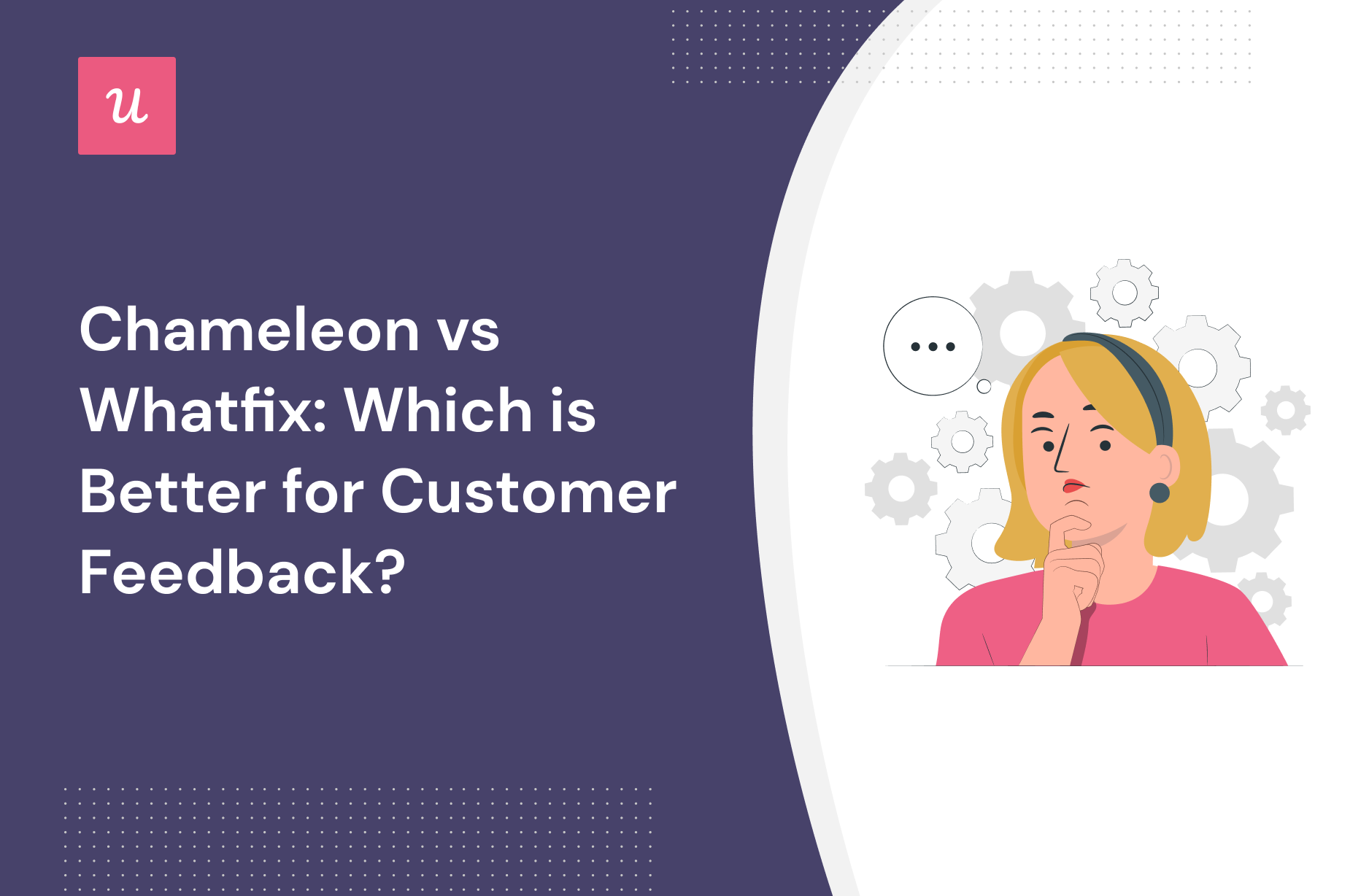
Try Userpilot Now
See Why 1,000+ Teams Choose Userpilot

Chameleon vs Whatfix: Feature comparison for collecting customer feedback
-
Customer feedback refers to qualitative and quantitative insights gleaned from actual users about their likes, dislikes, requests, and impressions of your product.
- Collecting customer feedback is an important task for any product team. It helps you understand your users’ needs, identify friction points and the weaknesses of your product, and make the necessary enhancements to improve customer satisfaction and retention.
- Using tools, non-technical people such as product managers or customer success managers can collect and analyze user feedback at scale, without having to rely on developers.
- A good customer feedback tool must have certain features: 1) the ability to create different types of in-app surveys, 2) customize surveys to match company branding, and 3) create segments based on responses to deliver customized experiences.
- With Whatfix, you can create in-app surveys, collect feedback on product tours, ask follow-up questions to collect actionable insights and send push reminders to customers so they don’t forget about providing feedback.
- As with any tool, Whatfix comes with its flaws. The platform doesn’t offer in-depth customization options for surveys and lacks analytics capabilities.
- Chameleon is another tool for collecting user feedback. It allows you to create multiple types of micro surveys, set the triggering frequency, and get access to basic completion reports.
- However, there is one major drawback to Chameleon: it isn’t a truly no-code tool, you will either need CSS knowledge or a developer’s help to customize the surveys created with it.
- None of these tools have what you are looking for? Consider Userpilot, the perfect alternative for collecting and analyzing customer feedback in-app. You can use survey templates out of the box, customize them to fit your brand and UI, and trigger them contextually using segmentation. Get a Demo to see it in action.
What is customer feedback?
Customer feedback is any information provided by customers about their experience with a product or service. By analyzing customer feedback, you can reveal their level of satisfaction and pinpoint areas for improvement.
Why should you care about customer feedback?
Customer feedback is important if you want to truly serve your customers and come up with solutions that can solve their pain points.
Here is why customer feedback matters:
- Understand whether customers see value in your product and if it meets their needs
- Uncover weak spots of your product and bottlenecks that disturb the customer journey
- Make your customers voices heard and acknowledge them that they are important to you
- Collect real-time insights on the go as you’re introducing new features or product updates
Why do you need tools for customer feedback?
Wondering why you even need a customer feedback tool? There are several reasons why you may need one:
Collecting customer feedback should be a standard procedure for any product team.It should be consistent and gained across different stages of the customer journey so you can measure customer experience in different situations. This might be time-consuming but thanks to customer feedback tools, the process can be hassle-free and literally without any coding.
Here’s how customer feedback tools help.
- Create different forms of microsurveys, such as NPS, CSAT, CES, PMF to collect contextual feedback
- Customize the surveys so they are aligned with your brand and match the interface of your app
- Segment customers by their feedback so you can create personalized flows for them
- Conduct a user sentiment analysis to understand your customers better
Now you might ask yourself, how to choose the right customer feedback tool for your SaaS? This is what we will be discussing next.
Must-have features for customer feedback tools
Before deciding which customer feedback tool works best, you should understand what features any solid tool must provide.
Here’s what to look for before making a buying decision:
- Make sure the tool you choose supports multiple forms of microsurveys. The most important and popular ones for collecting customer feedback include the Net Promoter Score, Customer satisfaction score, Customer effort score, product-market fit survey, etc
- You should also get customization capabilities so that the surveys you create match your interface and don’t look odd. No tool branding is also preferable
- Feedback analytics and response monitoring are the next key features if you want to not only collect feedback but also analyze it and understand the intent behind your customers’ scores.
- Integration with 3rd party survey and analytics tools so you can enrich your surveys to make the most out of the customer feedback
There you have it. These are the basic features you should be looking for, but the tool you should go with must be dependent on your specific goals. You might need a tool that must cover all of these features but if you don’t need complex features, you should be completely ok with a tool with limited functionalities.
Chameleon for customer feedback
Chameleon is a digital adoption platform with a difference: while the other tools discussed are mostly no-code, Chameleon will require some developer involvement.
Nevertheless, it’s a powerful and effective tool that works in a similar way to Userpilot and offers similar features: styling, analytics, templates, goals, A/B testing, and checklists.
However, it doesn’t offer a resource center, or dedicated NPS, and it’s a lot worse value for money with limited features in the basic plan, which is over $150 more expensive for the same number of MAUs.
Here’s how you can collect user feedback with Chameleon:
- Build different types of micro surveys (limited to 5 on the Startup plan) such as NPS, CSAT, CES, Opt-in, and custom feedback types.
- Personalize the surveys as you wish (you will need help from a developer or may require CSS skills).
- You can select the survey’s frequency and whether you want it to repeat.
- You get access to basic completion reports. Most of the additional data will need to be analyzed in your analytics tools that Chameleon integrates with and sends data to.
- You will see your NPS score in the reports but for the rest of the micro surveys, you will need analytics tools.
It’s great that Chameleon lets you build beautiful micro surveys but it might not be the best tool if you want to analyze the data and most importantly act on it. For example, with Userpilot you can create custom user segments based on survey responses or NPS scores and trigger specific in-app flows for them.
Pros of Chameleon?
Chameleon is a robust tool for your onboarding and adoption needs. Here are the main pros to consider if you’re still deciding:
- Offers a good range of in-app messaging and UI patterns. You can create custom modals, slideouts, tooltips, hotspots, launchers (checklists or resource hub), and more.
- Good segmentation options, you can either build different user segments inside the product, or you can integrate your Chameleon account with other tools and import your data.
- Can be used on 3rd party tools, meaning you can use it for employee onboarding too.
- Offers a good range of two-way integrations: Mixpanel, Segment, Intercom, Customer.io, Segment, Hubspot etc.
Cons of Chameleon?
While Chameleon is a great tool, the main downside is the cost and restrictions you get with it. Here are the main cons of the tool:
- There are some limitations to user onboarding flows. You can’t run multiple in-app experiences at the same time, as you can in Userpilot. Instead, Chameleon enables you to create user onboarding campaigns (different sequences of product tours shown over time).
- It’s built for single-page apps: Chameleon can’t build flows that run over multiple URLs.
- Doesn’t offer a self-service resource center where users can access multiple guides and tutorials or contact support. It does provide launchers that are similar but more restricted. A launcher can be a checklist or a list of resources, but can’t be both.
- It has a steeper learning curve and it’s not a completely no-code tool.
- The Startup (starter) plan is quite restrictive and expensive (starts at $349/mo for 2500 MAU and includes 1 Launcher only and 5 micro surveys). You will need to go for Growth ($1249/mo) if you want to drive product adoption.
What users say about Chameleon?
Users appreciate Chameleon’s versatile functionalities. Let’s see what they have to say about it.
I love the variety of formats we can build in Chameleon, from interactive tooltips to progressive tours and launchers! It’s also really easy to track performance of each of these and adjust accordingly. The interface still feels quite clunky whenever I’m in build mode. For instance, I don’t like that I have to use markdown and CSS when formatting text instead of having an inline styling menu to select from. Then there’s also the issue of surveys or tour steps appearing where they’re not supposed to, apparently mistaking an element in another page for the anchor. -Nikki D
Chameleon is a good tool overall and it’s loved by its users. Most complaints are about the price and some limitations such as customization of tours and reporting and analytics.
I wish there was an easier way to schedule content for release and more button options on the Tours. However, I think the scheduling feature is coming soon! I also wish it was easier to customize how launchers look without needing to know how to code UI changes in. – Lubana L.
There is limited reporting and dashboarding functionality within Chameleon currently. – Administrator in Financial Services
I think the software is a bit on the pricey side, but since it lets us do things that we would normally need our developers to do, we are truly saving in the grand scheme of things. It means we can focus on features and bug fixes, instead of building a new communication method that would only be used internally!-Nathalie L.
Is Chameleon the right fit for your business?
Chameleon is a great tool but we can’t say it’s the best there is. Here are three main reasons why you might consider an alternative.
- To get access to all the needed tools for proper onboarding and adoption you need to pay for the higher plans that can get expensive.
- Chameleon focuses on customization but in most cases, you will need a lot of CSS to achieve the look and feel of your brand. There are other tools that are truly no-code.
- If you need proper product and user analytics without having to pay for extra tools and integrate with Chameleon, you might need to consider a different tool.
Chameleon pricing
Chameleon split their pricing options primarily by the number of monthly active users, but you should keep in mind that the Startup plan also has limited features and might not be enough for interactive user onboarding and adoption for SaaS products:
- 0 – 2500 MAUs: Startup plan from $349/mo, Growth plan from $1249/mo
- 2000 – 3000MAUs: Startup plan from $419/mo, Growth from $1299/mo.
- 3000 – 5000 MAUs: Startup plan from $489/mo, Growth from $1449/mo.
- 5000 – 10,000 MAUs: Startup plan from $629/mo, Growth from $1749/mo
Disclaimer: with the Startup plan you only get 5 microsurveys and 1 launcher, no A/B testing, no Goals, and no localization.
There is a better tool for your SaaS than Chameleon!

Whatfix for customer feedback
Whatfix is one of the top digital adoption platforms around and a driver of innovation in this space.
Whatfix offers a well-made product that allows you to create user flows, knowledge bases, and task lists to get new users engaged and learning. On top of this, their analytics platform is easy to understand and helps you keep track of behavior analytics, guidance analytics, and user feedback all in one place.
If you want to collect user feedback on specific interactions, Whatfix is a good tool to build micro surveys for that
Here’s how you can collect user feedback with Whatfix:
- With user surveys, you can collect feedback on the onboarding tours and training flows, so you can continuously improve your product support.
- Whatfix’s in-app feedback surveys make it easy to gather feedback and insights from users in real-time.
- Add a follow-up question to enable open-minded feedback
- Send push reminders to customers so they don’t forget about providing feedback
However, if you want to build traditional NPS surveys with response tagging capabilities, then segment customers based on their feedback, Whatfix might not be the best fit for you. This is something that Userpilot offers.
Pros of Whatfix
There are many advantages when it comes to choosing Whatfix. Here are its pros.
- Easy to create flows, even for non-technical team members.
- Allows you to develop knowledge bases for self-help solutions.
- Ideal for both customer and employee onboarding.
Cons of Whatfix
But at the same time, Whatfix has some cons so it’s better to get an overview if you’re thinking of buying it:
- User experience issues, including bugs and sometimes spotty customer service.
- Fewer analytical features and views than you might like.
- Lacks in-depth style customizations.
- It’s difficult to integrate some of the scripted code in the admin integration sections without the help of a Whatfix support team member.
- No free trial option despite it being stated on the homepage.
- It’s targeted at enterprise accounts so small companies might get ignored.
What users say about Whatfix?
Overall, Whatfix is a good tool and customers are happy with the product. Here is what their customers say about the product.
Our Whatfix Customer Success Manager Kritika has been amazingly responsive to our questions and creative in finding solutions.
Their team really helped us during a project we were doing, and I think they would be great for any company looking for help. This is a must to onboard customers and drive retention.
Though Whatfix is considered a solid tool in the market some people have complaints. Mostly they are related to complications for non-technical people and instability.
Here is what they say:
We were promised a lot of features that weren’t as easy to use as they made it seem when we signed up.
The tool itself is challenging for the less technical people to use the tool, as you need to know the css classes to show flows and steps.
unexpected issues and roadblocks in implementation that can cause delay or a need for an alternate approach
Is Whatfix the right fit for your business?
Though Whatfix is a good tool for user/employee onboarding and it’s used by many companies, there are still some logical reasons why you might look for an alternative:
- It’s designed for enterprise companies and the pricing reportedly starts from $1200/per month. So it’s not something you’ll be delighted to buy if on budget.
- Whatfix doesn’t support NPS surveys so you can’t collect user feedback and measure customer loyalty
- Though you can create onboarding flows, tooltips, and beacons with Whatfix, there are many cost-efficient tools in the SaaS market that provide the same or even more functionality with customization options at a much lower cost.
Whatfix pricing
Whatfix doesn’t have any pricing plans on its website. Instead, you’ll need to speak with one of their team members to get a custom quote tailored to your needs and organization.
Otherwise, you can request a free trial to see if Whatfix works for you.
There is a better tool for your SaaS than Whatfix!

Is there a better alternative for customer feedback?
Chameleon and Whatfix are good tools for customer feedback. We’ve seen how they compare to each other and what you can achieve with them. Call us biased, but if you’re looking for something better, Userpilot offers more value for your money than these tools.
Userpilot for customer feedback
Userpilot is a powerful product adoption platform that enables you to quickly build personalized, flexible, contextually relevant in-app experiences targeted to different user segments – all without writing a line of code.
There are two types of feedback you should be focusing on collecting to better understand the health of your product and users.
First, you have user sentiment which looks at user satisfaction and effort scores or loyalty (using NPS surveys). Then you may also want to collect feedback on the functionality of the product or specific features.
You can do all these with Userpilot. In short, you can:
- Collect and track (NPS) in-app with a built-in NPS widget that allows you to fully customize the survey look and feel, and set the trigger frequency and specific targeting.
- Analyze NPS scores, tag responses, and use the data to create specific user segments.
- Build and trigger in-app micro surveys like the classic PMF survey, or similar ones and mix multi-choice and open-ended types of questions to collect specific insights.
- Be in charge of who gets which survey type and when with advanced segmentation capabilities, and of course, you can use the answers to segment your audience.
The advantage of using Userpilot for collecting feedback over other survey tools is that you can better control who sees the surveys but also you can instantly use the data collected to segment your user base and trigger the right experience for them.
For instance, if your users give you a low NPS score because they think you’re missing a critical feature (that you actually have already), you can push an interactive walkthrough guiding them to find and explore this feature.
Pros of Userpilot
Userpilot has a number of advantages, especially for mid-market SaaS companies looking for a robust but at the same time very easy-to-use, no-code tool for user onboarding, product adoption, and simplified product analytics. Let’s have a look at the pros of using Userpilot:
- No-code builder – Userpilot comes with an easy-to-use Chrome Extension builder.
- Multiple UI patterns – choose from a range of options to build customized flows: modals, slideouts, banners, tooltips, hotspots, and checklists are all at your disposal
- UI patterns are not limited by plan – you get access to all of them on every single plan, meaning you get value even with the Traction plan (this is the entry-level one).
- Engaging walkthroughs and onboarding flows- build interactive walkthroughs targeted to distinct user segments.
- In-app help – build a resource center offering self-service support to your users, customize it with your branding, and select from a range of help options to boost user satisfaction (i.e. videos, in-app flows, chat, and more).
- Experimentation – built-in A/B testing for flows lets you explore and quickly iterate based on direct user behavior.
- Powerful feedback options- integrated NPS surveys with analytics and response tagging unlock insight into how your users feel.
- Advanced analytics and segmentation- analyze product usage and in-app flow engagement and build user segments using the data.
- Event tracking and feature tags- tag UI engagement (clicks, form fills, hovers) and group them into one custom event to track what really matters.
- More value with integrations- unlock value faster with built-in integrations with popular tools like Segment, Amplitude, Mixpanel, Kissmetrics, Intercom, Heap, and more.
Cons of Userpilot
Userpilot has a number of advantages, especially for mid-market SaaS companies looking for a robust but at the same time very easy-to-use, no-code tool for user onboarding, product adoption, and simplified product analytics. Let’s have a look at the pros of using Userpilot:
- No-code builder – Userpilot comes with an easy-to-use Chrome Extension builder.
- Multiple UI patterns – choose from a range of options to build customized flows: modals, slideouts, banners, tooltips, hotspots, and checklists are all at your disposal
- UI patterns are not limited by plan – you get access to all of them on every single plan, meaning you get value even with the Traction plan (this is the entry-level one).
- Engaging walkthroughs and onboarding flows- build interactive walkthroughs targeted to distinct user segments.
- In-app help – build a resource center offering self-service support to your users, customize it with your branding, and select from a range of help options to boost user satisfaction (i.e. videos, in-app flows, chat, and more).
- Experimentation – built-in A/B testing for flows lets you explore and quickly iterate based on direct user behavior.
- Powerful feedback options- integrated NPS surveys with analytics and response tagging unlock insight into how your users feel.
- Advanced analytics and segmentation- analyze product usage and in-app flow engagement and build user segments using the data.
- Event tracking and feature tags- tag UI engagement (clicks, form fills, hovers) and group them into one custom event to track what really matters.
- More value with integrations- unlock value faster with built-in integrations with popular tools like Segment, Amplitude, Mixpanel, Kissmetrics, Intercom, Heap, and more.
What do users say about Userpilot?
Let’s check what real users like about Userpilot.
Userpilot is an incredible, user-friendly software that allows us to create unforgettable experiences for our clients! From basic to complex experiences, we have been able to do them all with ease! I would highly recommend this software to anyone who wants to provide their clients or users with the best product tour experience. The possibilities of what you can create are endless! – Tayla G.
Userpilot is simple to set up, use, and does not require any dev – which means instant publishing. This is critical for us as a SaaS company that releases new features frequently; we need the ability to inform our customers of changes quickly, and doing this in our platform through Userpilot allows us to reach the right audience, at the right time, in the right place. There have been many awesome extra features we’ve discovered since coming on board, and it’s been great to see new features released frequently. The tool itself is intuitive and reliable. Having used similar products previously that were clunky and buggy this has really made us happy with our decision to move to Userpilot. – Melina K.
Get more value for your money with Userpilot!

Userpilot pricing
Userpilot offers flexible pricing based on your monthly active users (MAUs). Plans start at $299 per month for smaller teams and scale as your user base grows.
Below are the pricing tiers you can choose from:
- The Starter plan begins at $299/month (billed annually) for up to 2,000 monthly active users. It includes in-app user engagement, usage trend analysis, NPS surveys, and essential product analytics—ideal for mid-market SaaS teams getting started.
- The Growth plan offers custom pricing and adds advanced analytics, retroactive event auto-capture, in-app surveys, session replay, and more. It’s the most popular choice for growing teams that need deeper insights and scale.
- The Enterprise plan offers custom pricing and includes everything in Growth, plus bulk data handling, custom roles and permissions, SOC 2 Type 2 compliance, and enterprise-level support.

Conclusion
There you have it.
It should be easier now to make an informed decision between Chameleon and Whatfix.
Both tools come with advantages and disadvantages so there isn’t one that is the best. It will depend on your product and current needs.
If you want the best value for money, going with the alternative option would be our recommendation. Want to see how Userpilot can help with customer feedback? Book a demo below.
There is a better tool for your SaaS than Chameleon!


